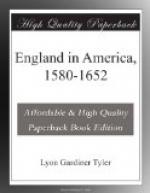The alarm created in Rhode Island by these proceedings brought the towns once more into a common policy, and Clarke and Williams were sent to England to undo the work of Coddington. Aided by the warm friendship of Sir Harry Vane, the efforts of the agents were crowned with success. Coddington’s commission was revoked by an order of council in September, 1652, and the townships were directed to unite under the charter of 1644.[28] Coddington did not at once submit, and there was a good deal of dissension in the Rhode Island towns till June, 1654, when Williams returned from England. Then Coddington yielded,[29] and, August 31, commissioners from the four towns voted to restore the government constituted seven years before. The consolidation of Rhode Island was perfected when, in 1658, Massachusetts released her claims to jurisdiction there.[30]
Liberty of conscience as asserted by Roger Williams did not involve the abrogation of civil restraint, and when one William Harris disturbed the peace in 1656, by asserting this doctrine in a pamphlet,[31] Williams, then governor, had a warrant issued for his apprehension. When, in 1658, Williams retired to private life the possibility of founding a state in which “religious freedom and civil order could stand together” was fully proved to the world.[32]
Besides the Indian power, as many as six independent jurisdictions existed originally in the present state of Connecticut. (1) The Dutch fort of “Good Hope,” established in 1633, on the Connecticut River, had jurisdiction over a small area of country. (2) The Plymouth colony owned some territory on the Connecticut River and built a fort there soon after the Dutch came. (3) Next was the jurisdiction of Fort Saybrook, the sole evidence of possession on the part of the holders of a patent from the earl of Warwick, president of the Council for New England, who claimed to own the whole of Connecticut. (4) A much larger jurisdiction was that of the Connecticut River towns, settled in 1635-1636, contemporaneously with the banishment of Roger Williams. (5) New Haven was settled in 1638, in the height of the Antinomian difficulties. (6) A claim was advanced by the marquis of Hamilton for a tract of land running from the mouth of the Connecticut River to Narragansett Bay, assigned to him in the division of 1635, but it did not become a disturbing factor till 1665.
The early relations between the Dutch and English colonies were, as we have seen, characterized by kindness and good-fellowship. The Dutch advised the Plymouth settlers to remove from their “present barren quarters,” and commended to them the valley of the “Fresh River” (Connecticut), referring to it as a fine place both for plantation and trade.[33] Afterwards, some Mohegan Indians visiting Plymouth in 1631 made similar representations. Their chief, Uncas, an able, unscrupulous, and ambitious savage, made it his great ambition to attain the headship of his aggressive western neighbors, the Pequots. The only result had been to turn the resentment of the Pequots against himself; and he sought the protection of the Plymouth government by encouraging them to plant a settlement on the Connecticut in his own neighborhood.[34]




